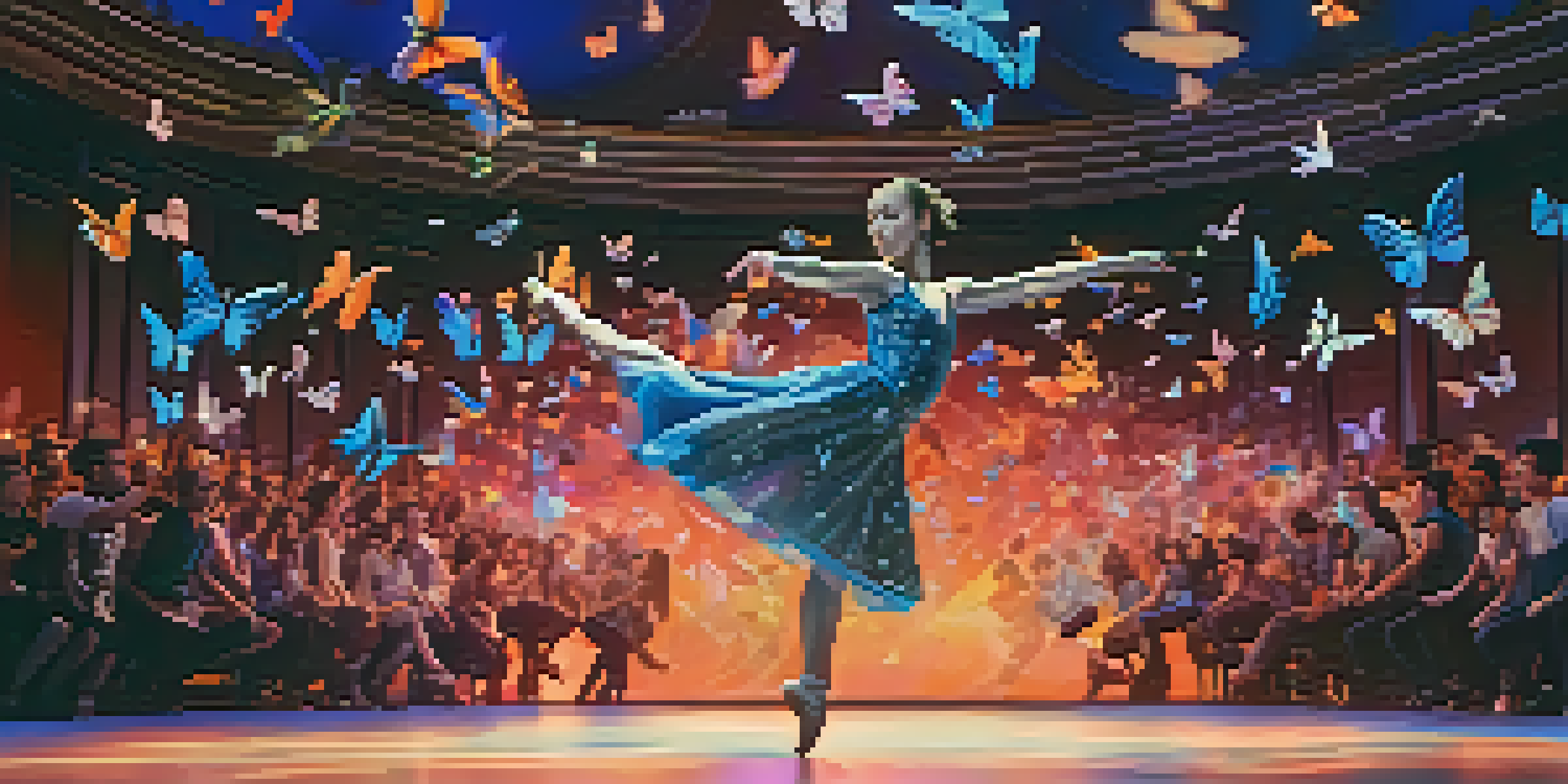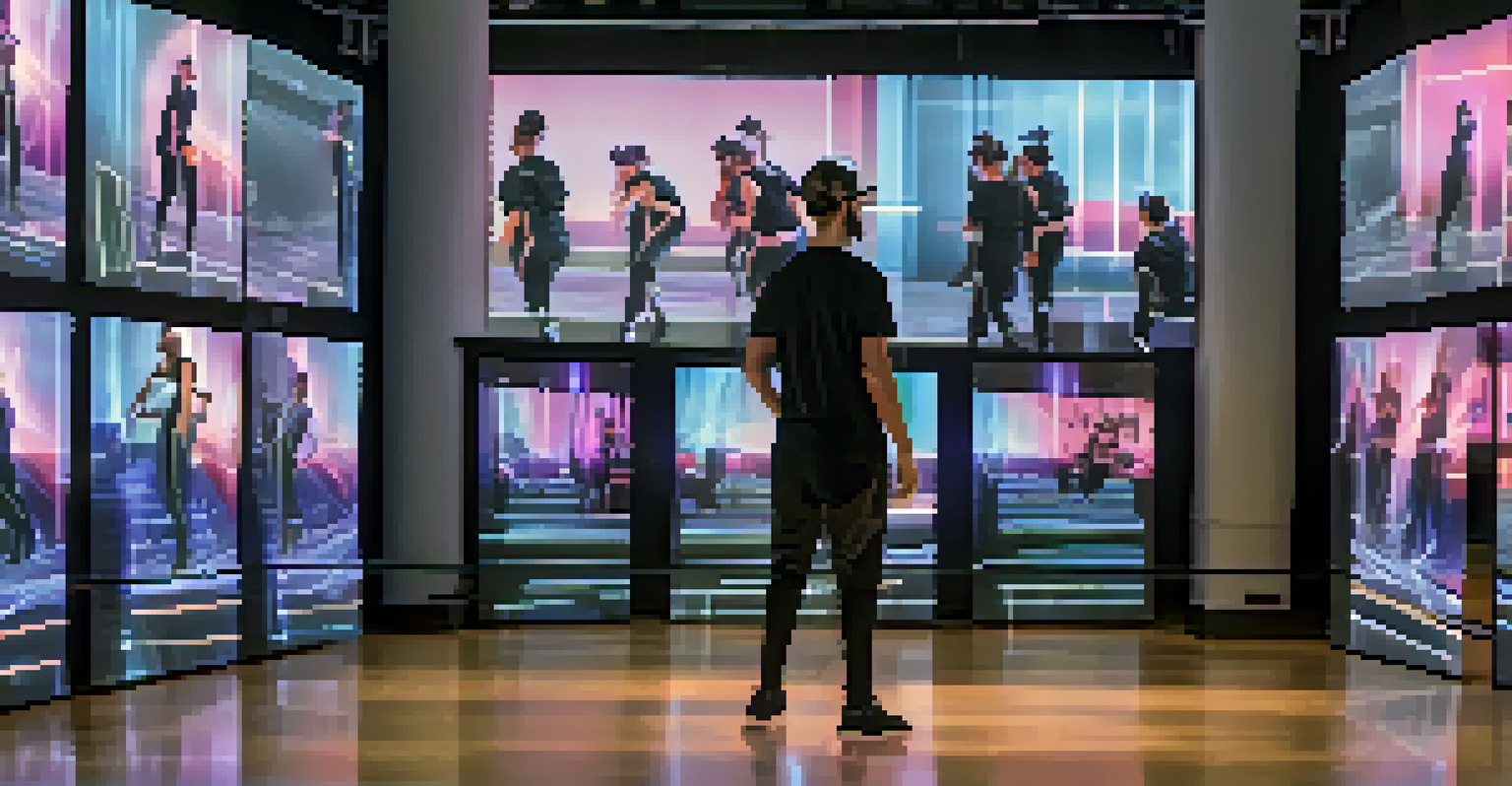Augmented Reality in Dance: Blending Digital with Performance

What is Augmented Reality and Its Role in Dance?
Augmented reality (AR) is a technology that overlays digital information onto the real world, enhancing our perception of reality. In the context of dance, AR creates immersive experiences by adding visual elements that dancers can interact with during performances. This blending of physical and digital realms opens up a new avenue for creativity in choreography and storytelling.
Augmented reality enables us to see the world differently, and the same is true for dance; it can transform our understanding and experience of the art.
For instance, a dancer might perform on stage while animated graphics swirl around them, choreographed to complement their movements. This not only captivates the audience but also allows for innovative interpretations of traditional dance forms. As AR technology evolves, its applications in dance become more sophisticated and dynamic.
The integration of AR is not just a gimmick; it’s a way to deepen the emotional impact of performances. By merging the physicality of dance with imaginative digital landscapes, artists can convey complex narratives, making each performance a unique experience for the audience.
How AR Enhances Audience Engagement
One of the most exciting aspects of augmented reality in dance is its ability to engage audiences in unprecedented ways. With AR, viewers can experience performances from different angles, literally stepping into the dance as if they were part of it. This interactive element creates a sense of connection that traditional performances might not achieve.

Imagine attending a dance show where, through a smartphone app, you can see additional layers of the story unfold right in front of you. This level of engagement invites audiences to interpret the performance actively, making them feel like co-creators rather than just spectators. It transforms a passive viewing experience into an active exploration of art.
AR Transforms Dance Performances
Augmented reality enhances dance by merging physical movements with digital visuals, creating immersive and innovative experiences for both performers and audiences.
Moreover, AR can bridge the gap between the performance and the audience's everyday lives. By allowing viewers to take home a piece of the experience through AR apps, the dance becomes a part of their personal narrative, fostering a deeper appreciation for the art form.
The Creative Process: Choreography Meets Technology
Choreographers are now incorporating augmented reality into their creative processes, pushing the boundaries of traditional dance. By using AR tools, they can visualize how movements will interact with digital elements before the actual performance. This foresight allows for more deliberate and innovative choreography, enhancing the overall production.
The future of dance lies in the fusion of technology and creativity, where every movement tells a story enhanced by innovative digital elements.
For example, a choreographer might design a sequence where dancers leap into a cloud of digital butterflies that react to their movements. This not only requires precise timing and coordination but also instills a sense of wonder and magic in the performance. The synergy between dancer and digital element invites a new realm of artistic exploration.
As technology continues to advance, the possibilities for choreography become virtually limitless. By embracing AR, dance artists can experiment with new forms, creating performances that challenge audiences and redefine what dance can be.
Case Studies: Successful AR Dance Performances
Several pioneering dance companies have successfully integrated augmented reality into their performances, showcasing the potential of this innovative approach. For instance, the Royal Ballet in London experimented with AR elements in their production, which allowed audiences to see additional visual layers that enhanced the storytelling.
Another notable example is the collaboration between choreographers and tech companies, where dancers performed against a backdrop of AR visuals that changed in real-time based on their movements. These performances not only wowed audiences but also generated buzz on social media, expanding their reach beyond the theater.
Engaging Audiences with AR
AR invites audiences to interact with performances, making them feel like active participants rather than just spectators.
Such case studies highlight how AR can elevate dance performances, making them more memorable and shareable. As more dance companies explore this integration, we can expect to see a growing trend that redefines audience expectations and experiences.
Challenges Facing AR in Dance
While the marriage of augmented reality and dance is captivating, it comes with its own set of challenges. One significant hurdle is the technical expertise required to create and implement AR elements effectively. Dancers and choreographers often need to collaborate with tech specialists, which can complicate the creative process and lead to additional costs.
Moreover, ensuring that the AR components enhance rather than overshadow the dance itself is a delicate balance. The focus should always remain on the performers and their movements, as too much digital distraction can detract from the emotional connection that dance traditionally offers.
Lastly, accessibility is another concern; not all audience members may have the necessary devices or familiarity with AR technology. Striking a balance between innovation and inclusivity remains a critical aspect of integrating AR into dance performances.
The Future of AR in Dance: Trends to Watch
As technology continues to advance, the future of augmented reality in dance looks promising. We can expect to see more seamless integrations, where digital elements are indistinguishable from the live performance. This evolution will likely involve improvements in AR hardware, making it more accessible to both artists and audiences.
Additionally, the rise of virtual reality (VR) and mixed reality (MR) could further blur the lines between live and digital experiences. Imagine a world where audiences can attend a performance from the comfort of their homes while feeling fully immersed in the environment created by AR and VR technologies.
Challenges of AR Integration
Despite its exciting potential, integrating AR into dance presents challenges such as technical expertise, maintaining focus on the performance, and ensuring accessibility for all audience members.
Finally, as more artists experiment with AR, we may witness a shift in how dance is perceived and experienced, leading to new forms of storytelling and expression. This ongoing evolution invites us to remain curious and open-minded about the future of dance and technology.
Conclusion: Embracing the New Frontier of Dance
The intersection of augmented reality and dance presents a thrilling new frontier for artists and audiences alike. By blending digital elements with live performance, we open up a world of possibilities that enhances storytelling and audience engagement. It's an exciting time for the dance community as they explore this innovative medium.
As we move forward, embracing technology does not mean losing the essence of dance; rather, it enriches the art form, making it more relevant in a rapidly changing world. The emotional power of dance remains intact, while AR provides new tools to amplify its impact.

In this dynamic landscape, it’s essential for dancers, choreographers, and audiences to be open to experimentation. By doing so, we can celebrate the beautiful fusion of tradition and innovation, ensuring that dance continues to evolve and thrive in the digital age.